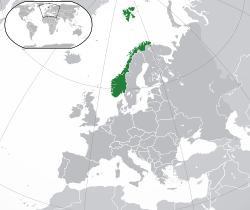


The following outline provides an overview of, and topical guide to, the Kingdom of Norway.
Contents
- General reference
- Geography of Norway
- Environment of Norway
- Regions of Norway
- Demography of Norway
- Government and politics of Norway
- Monarchy of Norway
- Branches of the government of Norway
- Foreign relations of Norway
- Law and order in Norway
- Military of Norway
- Local government in Norway
- History of Norway
- Culture of Norway
- Art in Norway
- Sports in Norway
- Economy and infrastructure of Norway
- Education in Norway
- See also
- Notes
- References
- External links
Norway is a sovereign constitutional monarchy, located principally in the western part of Scandinavia in Northern Europe. [1] The country has land borders with Sweden, Finland, and Russia, while the United Kingdom and the Faroe Islands lie to its west across the North Sea and Denmark to its south across the Skagerrak strait. The country's long and glaciated Atlantic coastline is deeply indented by fjords, rising precipitously to high plateaux.
Norway also includes the Arctic island territories of Svalbard and Jan Mayen. Norwegian sovereignty over Svalbard is based upon the Spitsbergen Treaty, but that treaty does not apply to Jan Mayen. Bouvet Island in the South Atlantic Ocean and Peter I Island and Queen Maud Land in Antarctica are external dependencies, but those three entities do not form part of the kingdom.
Since World War II, Norway has experienced rapid economic growth, and is now amongst the wealthiest countries in the world. [a] Norway is the world's third largest oil exporter after Russia and Saudi Arabia and the petroleum industry accounts for around a quarter of GDP. [2] It has also rich resources of gas fields, hydropower, fish, forests, and minerals. Norway was the second largest exporter of seafood (in value, after China) in 2006. [3] Other main industries include food processing, shipbuilding, metals, chemicals, mining and pulp and paper products. Norway has a Scandinavian welfare system and the largest capital reserve per capita of any nation.
Norway was ranked highest of all countries in human development from 2001 to 2006, and came second in 2007 (to fellow Nordic country Iceland). [b] It also rated the most peaceful country in the world in a 2007 survey by Global Peace Index. [4] It is a founding member of NATO.




